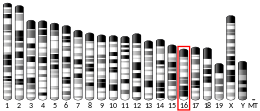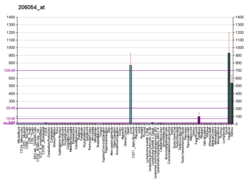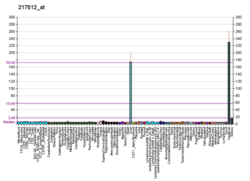Kininogen 1
Kininogen-1 (KNG1), also known as alpha-2-thiol proteinase inhibitor, Williams-Fitzgerald-Flaujeac factor or the HMWK-kallikrein factor is a protein[5] that in humans is encoded by the KNG1 gene.[6][7] Kininogen-1 is the precursor protein to high-molecular-weight kininogen (HMWK), low-molecular-weight kininogen (LMWK), and bradykinin.[5]
Expression
The KNG1 gene uses alternative splicing to generate two different proteins: high-molecular-weight kininogen (HMWK) and low-molecular-weight kininogen (LMWK). HMWK in turn is cleaved by the enzyme kallikrein to produce bradykinin.
- KNG1 gene → low-molecular-weight kininogen (LMWK) protein (contains 427 amino acids) or high-molecular-weight kininogen (HMWK) protein (644 amino acids)
- HMWK protein → bradykinin peptide (9 amino acids)
Function
HMWK is essential for blood coagulation and assembly of the kallikrein-kinin system. Also, bradykinin, a peptide causing numerous physiological effects, is released from HMWK. In contrast to HMWK, LMWK is not involved in blood coagulation.[6]
Kininogen-1 is a constituent of the blood coagulation system as well as the kinin-kallikrein system.
References
- GRCh38: Ensembl release 89: ENSG00000113889 - Ensembl, May 2017
- GRCm38: Ensembl release 89: ENSMUSG00000060459 - Ensembl, May 2017
- "Human PubMed Reference:". National Center for Biotechnology Information, U.S. National Library of Medicine.
- "Mouse PubMed Reference:". National Center for Biotechnology Information, U.S. National Library of Medicine.
- UniProt: P01042
- "Entrez Gene: kininogen 1".
- GeneCard for KNG1 KNG1
Further reading
- Iarovaia GA (2001). "[Kallikrein-kinin system: novel facts and concepts (literature review)]". Voprosy Medit͡sinskoĭ Khimii. 47 (1): 20–42. PMID 11385996.
- Matthews KW, Mueller-Ortiz SL, Wetsel RA (Jan 2004). "Carboxypeptidase N: a pleiotropic regulator of inflammation". Molecular Immunology. 40 (11): 785–93. doi:10.1016/j.molimm.2003.10.002. PMID 14687935.
- Scharfstein J, Schmitz V, Svensjö E, Granato A, Monteiro AC (2007). "Kininogens coordinate adaptive immunity through the proteolytic release of bradykinin, an endogenous danger signal driving dendritic cell maturation". Scandinavian Journal of Immunology. 66 (2–3): 128–36. doi:10.1111/j.1365-3083.2007.01983.x. PMID 17635790.
- Thompson RE, Mandle R, Kaplan AP (Oct 1979). "Studies of binding of prekallikrein and Factor XI to high molecular weight kininogen and its light chain". Proceedings of the National Academy of Sciences of the United States of America. 76 (10): 4862–6. doi:10.1073/pnas.76.10.4862. PMC 413037. PMID 291905.
- Kerbiriou DM, Griffin JH (Dec 1979). "Human high molecular weight kininogen. Studies of structure-function relationships and of proteolysis of the molecule occurring during contact activation of plasma". The Journal of Biological Chemistry. 254 (23): 12020–7. PMID 500690.
- Colman RW, Bagdasarian A, Talamo RC, Scott CF, Seavey M, Guimaraes JA, Pierce JV, Kaplan AP (Dec 1975). "Williams trait. Human kininogen deficiency with diminished levels of plasminogen proactivator and prekallikrein associated with abnormalities of the Hageman factor-dependent pathways". The Journal of Clinical Investigation. 56 (6): 1650–62. doi:10.1172/JCI108247. PMC 333144. PMID 1202089.
- Gailani D, Broze GJ (Aug 1991). "Factor XI activation in a revised model of blood coagulation". Science. 253 (5022): 909–12. doi:10.1126/science.1652157. PMID 1652157.
- Cheung PP, Cannizzaro LA, Colman RW (1992). "Chromosomal mapping of human kininogen gene (KNG) to 3q26----qter". Cytogenetics and Cell Genetics. 59 (1): 24–6. doi:10.1159/000133192. PMID 1733668.
- Fong D, Smith DI, Hsieh WT (Jun 1991). "The human kininogen gene (KNG) mapped to chromosome 3q26-qter by analysis of somatic cell hybrids using the polymerase chain reaction". Human Genetics. 87 (2): 189–92. doi:10.1007/BF00204179. PMID 2066106.
- Schmaier AH, Kuo A, Lundberg D, Murray S, Cines DB (Nov 1988). "The expression of high molecular weight kininogen on human umbilical vein endothelial cells". The Journal of Biological Chemistry. 263 (31): 16327–33. PMID 2460446.
- Takagaki Y, Kitamura N, Nakanishi S (Jul 1985). "Cloning and sequence analysis of cDNAs for human high molecular weight and low molecular weight prekininogens. Primary structures of two human prekininogens". The Journal of Biological Chemistry. 260 (14): 8601–9. PMID 2989293.
- Kitamura N, Kitagawa H, Fukushima D, Takagaki Y, Miyata T, Nakanishi S (Jul 1985). "Structural organization of the human kininogen gene and a model for its evolution". The Journal of Biological Chemistry. 260 (14): 8610–7. PMID 2989294.
- Ishiguro H, Higashiyama S, Namikawa C, Kunimatsu M, Takano E, Tanaka K, Ohkubo I, Murachi T, Sasaki M (May 1987). "Interaction of human calpains I and II with high molecular weight and low molecular weight kininogens and their heavy chain: mechanism of interaction and the role of divalent cations". Biochemistry. 26 (10): 2863–70. doi:10.1021/bi00384a030. PMID 3038169.
- Vogel R, Assfalg-Machleidt I, Esterl A, Machleidt W, Müller-Esterl W (Sep 1988). "Proteinase-sensitive regions in the heavy chain of low molecular weight kininogen map to the inter-domain junctions". The Journal of Biological Chemistry. 263 (25): 12661–8. PMID 3045123.
- Maeda H, Matsumura Y, Kato H (Nov 1988). "Purification and identification of [hydroxyprolyl3]bradykinin in ascitic fluid from a patient with gastric cancer". The Journal of Biological Chemistry. 263 (31): 16051–4. PMID 3182782.
- Kato H, Matsumura Y, Maeda H (May 1988). "Isolation and identification of hydroxyproline analogues of bradykinin in human urine". FEBS Letters. 232 (1): 252–4. doi:10.1016/0014-5793(88)80427-7. PMID 3366244.
- Kellermann J, Lottspeich F, Henschen A, Müller-Esterl W (Jan 1986). "Completion of the primary structure of human high-molecular-mass kininogen. The amino acid sequence of the entire heavy chain and evidence for its evolution by gene triplication". European Journal of Biochemistry / FEBS. 154 (2): 471–8. doi:10.1111/j.1432-1033.1986.tb09421.x. PMID 3484703.
- Kellermann J, Thelen C, Lottspeich F, Henschen A, Vogel R, Müller-Esterl W (Oct 1987). "Arrangement of the disulphide bridges in human low-Mr kininogen". The Biochemical Journal. 247 (1): 15–21. doi:10.1042/bj2470015. PMC 1148362. PMID 3689342.
- Warn-Cramer BJ, Bajaj SP (Dec 1985). "Stoichiometry of binding of high molecular weight kininogen to factor XI/XIa". Biochemical and Biophysical Research Communications. 133 (2): 417–22. doi:10.1016/0006-291X(85)90922-2. PMID 3936495.
- Lottspeich F, Kellermann J, Henschen A, Foertsch B, Müller-Esterl W (Oct 1985). "The amino acid sequence of the light chain of human high-molecular-mass kininogen". European Journal of Biochemistry / FEBS. 152 (2): 307–14. doi:10.1111/j.1432-1033.1985.tb09199.x. PMID 4054110.





